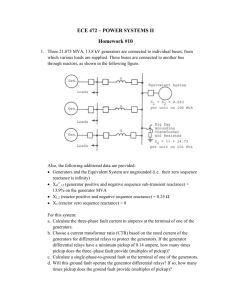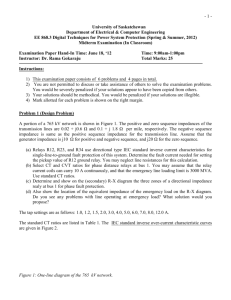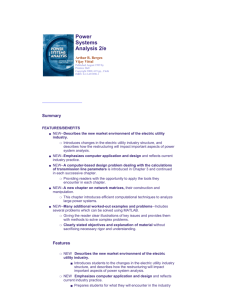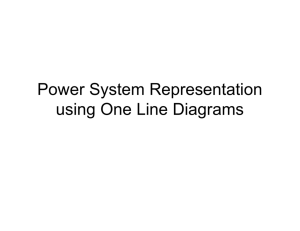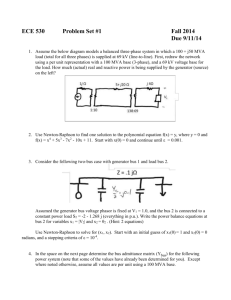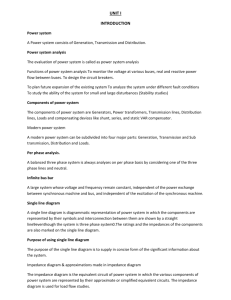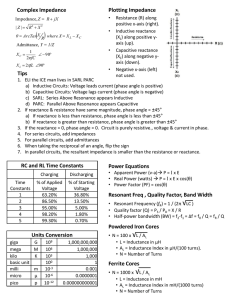psa-question paper
advertisement
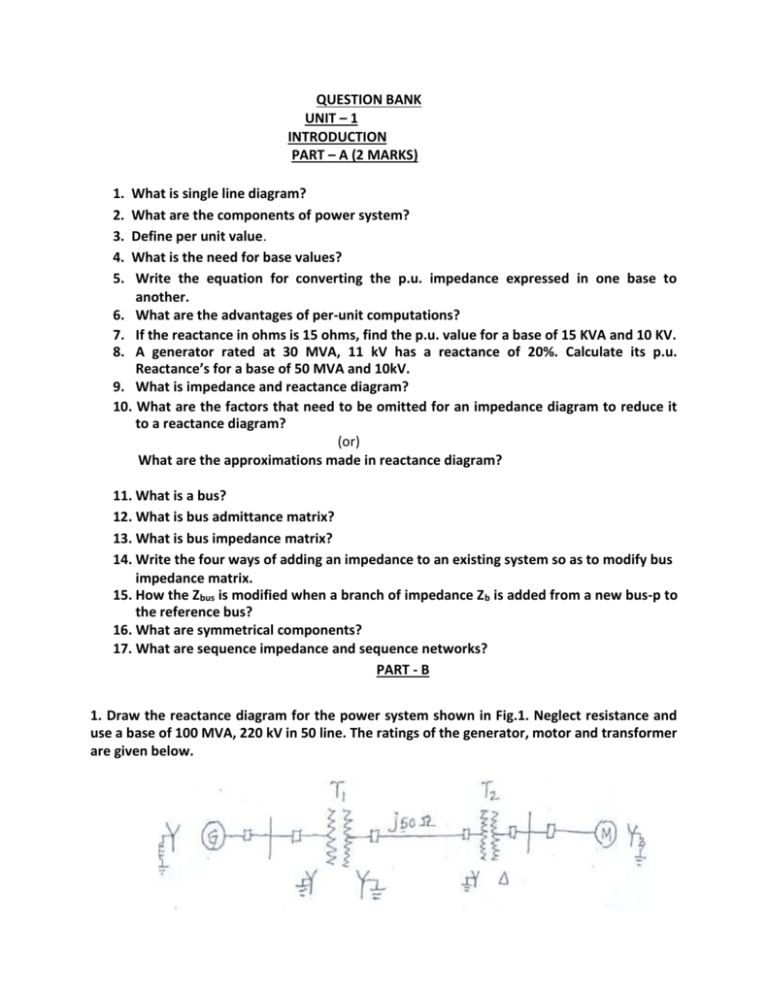
QUESTION BANK UNIT – 1 INTRODUCTION PART – A (2 MARKS) 1. 2. 3. 4. 5. What is single line diagram? What are the components of power system? Define per unit value. What is the need for base values? Write the equation for converting the p.u. impedance expressed in one base to another. 6. What are the advantages of per-unit computations? 7. If the reactance in ohms is 15 ohms, find the p.u. value for a base of 15 KVA and 10 KV. 8. A generator rated at 30 MVA, 11 kV has a reactance of 20%. Calculate its p.u. Reactance’s for a base of 50 MVA and 10kV. 9. What is impedance and reactance diagram? 10. What are the factors that need to be omitted for an impedance diagram to reduce it to a reactance diagram? (or) What are the approximations made in reactance diagram? 11. What is a bus? 12. What is bus admittance matrix? 13. What is bus impedance matrix? 14. Write the four ways of adding an impedance to an existing system so as to modify bus impedance matrix. 15. How the Zbus is modified when a branch of impedance Zb is added from a new bus-p to the reference bus? 16. What are symmetrical components? 17. What are sequence impedance and sequence networks? PART - B 1. Draw the reactance diagram for the power system shown in Fig.1. Neglect resistance and use a base of 100 MVA, 220 kV in 50 line. The ratings of the generator, motor and transformer are given below. Fig. 1 Generator: 40 MVA, 25 kV, X” = 20% Synchronous motor : 50 MVA, 11 kV, X” = 30% Y – Y Transformer : 40 MVA, 33/220 kV, X = 15% Y - 30 MVA, 11/220 kV, ( /Y), X = 15% (16) 2. Draw the structure of an electrical power system and describe the components of the system with typical values 3. Obtain the per unit impedance (reactance) diagram of the power system shown in Fig.3 Fig. 3 One-line representation of a simple power system. Generator No. 1: 30 MVA, 10.5 kV, X” = 1.6 Ohm Generator No. 2: 15 MVA, 6.6 kV, X” = 1.2 Ohm Generator No. 3: 25 MVA, 6.6 kV, X” = 0.56 Ohm Transformer T1 (3phase) : 15 MVA, 33/11 kV, X = 15.2 Ohm per phase on HT side Transformer T2 (3phase) : 15 MVA, 33/6.2 kV, X = 16 Ohm per phase on HT side Transmission line : 20.5 Ohm/phase Load A : 15 MW, 11kV, 0.9 p.f. lagging Load B : 40 MW, 6.6 kV, 0.85 lagging p.f. 4. Explain the modeling of generator, load, transmission line and transformer for power flow, short circuit and stability studies. 5. Choosing a common base of 20 MVA, compute the per unit impedance (reactance) of the components of the power system shown in Fig.5 and draw the positive sequence impedance (reactance) diagram. Fig. 5 Gen 1 : 20 MVA, 10.5 kV, X” = 1.4 Ohm Gen 2 : 10 MVA, 6.6 kV, X” = 1.2 Ohm Tr 1 : 10 MVA, 33/11 kV, X = 15.2 Ohm per phase on HT side Tr 2 : 10 MVA, 33/6.2 kV, X = 16.0 Ohm per phase on HT side Transmission line : 22.5 Ohms per phase . 6. (i) What are the step by step procedures to be followed to find the per-unit impedance diagram of a power system? (ii) Draw the structure of an electrical power system and describe the components of the system with typical values. 7. Write short notes on: (i) Single line diagram (ii) Change of base. (iii) Reactance of synchronous machines. 8. A 120 MVA, 19.5 kV Generator has a synchronous reactance of 0.15 p.u and it is connected to a transmission line through a Transformer rated 150 MVA, 230/18 kV (star/delta) with X = 0.1 p.u. (i) Calculate the p.u reactance by taking generator rating as base values (ii) Calculate the p.u reactance by taking transformer rating as base values. (iii) Calculate the p.u reactance for a base value of 100 MVA and 220 kV on H.T side of transformer. UNIT – 2 POWER FLOW ANALYSIS PART – A (2 MARKS) 1. What is power flow study or load flow study? 2. What are the works involved in a load flow study? or How a load flow study is performed? 3. List the quantities specified and the quantities to be determined to be determined from load flow study for various types of buses. 4. Define Voltage controlled bus. 5. What is PQ-bus? 6. What is swing bus (or slack bus)? 7. What is the need for slack bus? 8. Write the expression for complex power injected to a bus. 9. Write the load flow equation of Gauss and Gauss-Seidel method. 10. Write the load –flow equations of Newton-Raphson method. 11. Discuss the effect of acceleration factor in the load flow solution algorithm. How will you account for voltage controlled buses in this algorithm? 12. Why do we go for iterative methods to solve flow problems? 13. What will be the reactive power and bus voltage when the generator bus is treated as load bus? 14. Compare the G-S and N-R methods of load flow solutions. 15. How the convergence of N-R method is speeded up? 16. How the disadvantages of N-R method are overcome? 17. What is the need for voltage control in a power system? 18. Mention the various methods of voltage control employed in power system. 19. What is infinite bus? 20. How the reactive power of a generator is controlled? 21. What are the drawbacks in voltage control using generator excitation? 22. What is the disadvantage in reactive power compensation by shunt capacitors and how it is overcome? 23. What is the drawback in series connected capacitor? 24. Compare the reactive power compensation by shunt and series capacitors. 25. What are the advantages of synchronous capacitors over static capacitors? 26. What is the main difference in voltage control by capacitors and transformers? 27. What is regulating transformer and booster transformer? 28. What is off-nominal transformer ratio? Draw the equivalent circuit of a transformer with off-nominal transformer ratio connected to a transmission line. PART – B 1. Derive load flow algorithm using Gauss – Seidel method with flow chart and discuss the advantages of the method. 2. Derive load flow algorithm using Newton-Raphson method with flow chart and state the importance of the method. 3. Explain clearly the algorithmic steps for solving load flow equation using Newton – Raphson method (polar form) when the system contains all types of buses. Assume that the generators at the P-V buses have adequate Q Limits. 4. Explain the step by step procedure for the NR method of load flow studies. 5. Find the bus admittance matrixnode for 4. the Determine admittance matrix by eliminating Thegiven valuesnetwork. are marked in p.u. the reduced 6. Find the bus impedance matrix for the system whose reactance diagram is shown in fig. All the impedances are in p,u. 7. (i) Derive the power flow equation in polar form. (ii)Write the advantages and disadvantages of Gauss-Seidel method and Newton-Raphson method. 8. The parameters of a 4-bus system are as under: Bus code Line impedance Charging admittance (pu) (pu) s1-2 0.2 + j 0.8 j 0.02 2-4 0.25 +j 1.0 j 0.04 3-4 0.2 + j 0.8 j 0.02 1-3 0.1 + j0.4 j 0.01 Draw the network and find bus admittance matrix. 9. With a flow chart, explain the NR Iterative method for solving load flow problem. 10. (i) Compare Gauss-Seidel method and Newton-Raphson method of load flow studies (ii) Fig.12 shows a three bus power system. Bus 1 : Slack bus, V= 1.05/00 p.u. Bus 2 : PV bus, V = 1.0 p.u. Pg = 3 p.u. Bus 3 : PQ bus, Pl = 4 p.u., Ql = 2 p.u. Carry out one iteration of load flow solution by Gauss Seidel method. Neglect limits on reactive power generation. UNIT-III SYMMETRICAL FAULT ANALYSIS PART – A (2 MARKS) 1. What is meant by a fault? 2. How the faults are classified? 3. List the various types of shunt and series faults. 4. Name the main differences in representation of power system for load flow and short circuit studies. 5. For a fault at a given location, rank the various faults in the order of severity. In a power system relatively the most severe fault is three phase fault and less severe fault is open conductor fault. 6. What is the need for short circuit studies or fault analysis? 7. What is the reason for transients during short circuits? 8. What is meant by doubling effect? 9. What is synchronous reactance? 10. Define sub transient reactance. 11. What is the significance of sub-transient reactance in short circuit studies? 12. How symmetrical faults are analyzed? 13. What are the main factors to be considered to select a circuit breaker? 14. Why the circuit breaker interrupting current is asymmetrical? 15. What is momentary current rating of circuit breaker? How it si estimated? 16. Define short circuit interrupting MVA of a circuit breaker. PART – B 1. A generator is connected through a transformer to a synchronous motor the sub transient reactance of generator and motor are 0.15 p.u. and 0.35 p.u. respectively. The leakage reactance of the transformer is 0.1 p.u. All the reactances are calculated on a common base. A three phase fault occurs at the terminals of the motor when the terminal voltage of the generator is 0.9 p.u. The output current of generator is 1 p.u. and 0.8 p.f. leading. Find the sub transient current in p.u. in the fault, generator and motor. Use the terminal voltage of generator as reference vector. 2. Explain the step by step procedure for systematic fault analysis using bus impedance matrix. 3. A 60 MVA, Y connected 11 KV synchronous generator is connected to a 60 MVA, 11/132 KV /Y transformer. The sub transient reactance X”d of the generator is 0.12 p.u. on a 60 MVA base, while the transformer reactance is 0.1 p.u. on the same base. The generator is unloaded when a symmetrical fault is suddenly placed at point p as shown in Fig. 3 Find the sub transient symmetrical fault current in p.u. amperes and actual amperes on both side of the transformer. Phase to neutral voltage of the generator at no load is 1.0 p.u. Fig. 3 4. A three –phase transmission line operating at 33 KV and having a resistance and reactance of 5 Ohms and 15 Ohms respectively is connected to the generating station bus-bar through a 5000 KVA step up transformer which has a reactance of 0.05 p.u. Connected to the bus-bars are two alternators, are 10,000 KVA having 0.08 p.u. reactance and another 5000 KVA having 0.06 p.u. reactance. Calculate the KVA at a short circuit fault between phases occurring at the high voltage terminals of the transformers. 5. A synchronous generator and a synchronous motor each rated 25 MVA, 11 KV having 15% sub-transient reactance are connected through transformers and a line as shown in fig. The transformers are rated 25 MVA< 11/66 KV and 66/11 KV with leakage reactance of 10% each. The line has a reactance of 10% on a base of 25 MVA, 66 Kv. The motor is drawing 15 MW at 0.5 power factor leading and a terminal voltage of 10.6 KV. When a symmetrical 3 phase fault occurs at the motor terminals. Find the sub-transient current in the generator, motor and fault. 6. A three phase power of 700 MW is to be transmitted to a substation located 315 kM from the source of power. For a preliminary line design assume the following parameters: Vs = 1.0 p.u., Vr + 0.9 p.u. = 5000 km ; zc = 320 Ώ, and Ś = 36.870 . (i) Based on the practical line load ability equation, determine a nominal voltage level for the transmission line. (ii) For the transmission voltage level obtained in (i) Calculate the theoretical maximum power that can be transferred by the transmission line. 7. A 25,000 KVA, 13.8 kV generator with X”d = 15% is connected through a transformer to a bus which supplies four identical motors as shown in Fig. 7 The sub transient reactance X” d of each motor is 20% on a base of 5000 KVA, 6.9 kV. The three-phase rating of the transformer is 25,000 KVA, 13.8/6.9 kV, with a leakage reactance of 10%. The bus voltage at the motors is 6.9 kV when a three-phase fault occurs at point p. for the fault specified, determine (i) the sub transient current in the fault (ii) the sub transient current in breaker A and (iii) the symmetrical short-circuit interrupting current in the fault and in breaker A. Fig.7 one line diagram 8.Determine Zbus for the network shown below in Fig. 8 where the impedances labeled 1 through 6 are shown in per unit. Preserve all buses. Fig. 8 Fig. 8 Branch impedances are in p.u. and branch numbers are in parentheses. 9. With a help of a detailed flowchart, explain how a symmetrical fault can be analyzed using Zbus ? 10.(i) For the radial network shone below a three phase fault occurs at F. Determine the fault current and the line voltage at 11 kV bus under fault conditions. (ii) Explain the procedure for making short-circuit studies of a large power system networks using digital computers. 11. Two synchronous machines are connected through three phase transformers to the transmission line shown in Fig.11 the ratings and reactance of the machines and transformers are Machine 1 and 2 : 100 MVa, 20kV; X”d = X1 = X2 = 20% X0 = 4%, Xn = 5% Transformers T1 and T2 : 100 MVA, 20 /345 YkV ; X = 8%. On a chosen base of 100 MVA, 345 kV in the transmission line circuit the line reactances are X1 = X2 = 15% and X0 = 50%. Draw each of the three sequence networks and find the zero sequence bus impedance matrixes by means of Zbus building algorithm. Fig.11 UNIT-IV UNSYMMETRICAL FAULT ANALYSIS PART – A (2 MARKS) 1. Name the various unsymmetrical faults in a power system. 2. Name the faults which the zero sequence currents flowing 3. Define positive sequence impedance. 4. What is meant by a fault? 5. What is synchronous reactance? 6. Define subtransient reactance. 7. What is the significance of subtransient reactance and transient reactance in short circuit studies? 8. Define doubling effect and DC off-set current. 8. Differentiatebetween subtransient and transient reactance. 9. What are symmetrical components? 10. Write the symmetrical components of three phase system. 12. Express the unbalanced voltages Va, Vb and Vc in terms of symmetrical components Va1, Va2 and Va0. 13. Express the symmetrical components Va1, Va2 and Va0 in terms of unbalanced Vectors Va, Vb and Vc. PART- B 1. Derive the expression for fault current in Line-to-Line fault on an unloaded generator in terms of symmetrical components. 2. Determine the fault current and MVA at faulted bus for a line to ground (solid) fault at bus 4 as shown in Fig.2 G1, G2 : 100 MVA, 11kV, X+ + X- = 15%, X0 = 5%, Xn = 6% T1 T2 : 100 MVA, 11kV/220 kV, Xl\leak = 9% L 1,L2 : X+ = X- = 10%, X0 = 10% on base of 100 MVA. Consider a fault at phase a’. 3. A single line to ground fault occurs on bus 4 of the system shown in Fig.3 (i) Draw the sequence networks and (ii) Compute the fault current Fig. 3 Gen 1 and 2 : 100 MVA, 20kV; X’ = X’ ’ 20% ; X0 = 4%; Xn = 5%. Transformer 1 and 2 : 100 MVA, 20/345 KV; Xleakage = 8% on 100 MVA Tr. Line : X’ = X’ = 15% X0 = 50% on a base of 100 MVA, 20 kV. 4.. Draw the Zero sequence diagram for the system whose one line diagram is shown in fig. 5. Two synchronous machines are connected through three-phase transformers to the transmission line as given below in Fig. 5. The ratings and reactance of the machines and transformers are Machines 1 and 2 : 100 MVA, 20 Kv; X”d = X 1 = X2 = 20% X0 = 4%; Xn = 5%. Transformers T1 and T2 : 100 Mva, 20y/345 YkV ; X= 8%.Both transformers are solidly grounded on two sides. On a chosen base of 100 MVA, 345 kV in the transmission line circuit the line reactance are X 1 =X2 = 15% and X0 = 50%. The system is operating at nominal voltage without prefault currents when a bolted (Zf = o) single line-to-ground fault occurs on phase A at bus (3) Using the bus impedance matrix for each of the three sequence networks, determine the sub transient current to ground at the fault. Fig.5 6. Determine the positive, negative and zero sequence networks for the system shown in Fig. 6. Assume zero sequence reactance for the generator and synchronous motors as 0.06 p.u. current limiting reactors of 2.5 Ώ are connected in the neutral of the generator and motor No.2 The zero sequence reactance of the transmission line is j 300 Ώ. 7. Develop the connection of sequence network when a line to line fault occurs in a power network. 8. Derive the expression for fault current in double line to ground fault on unloaded generator. Draw an equivalent network showing the inter connection of networks to simulate double line to ground fault UNIT – V STABILITY ANALYSIS PART – A (2 MARKS) 1. 2. 3. 4. 5. 6. Define Steady state stability. Define transient stability. What is steady state stability limit? What is transient stability limit? How stability studies are classified, what are they? In a 3- machine system having ratings G1’ G2 and G 3 and inertia constants M1’ M2 and M3’ what is the inertia constants M and H of the equivalent system. 7. Define synchronizing coefficient. For what value of synchronizing coefficient the system remains stable. 8. Define swing curve. What is the use of swing curve? 9. Give the simplified power angle equation and the expression for Pmax 9. Define power angle. 11. Define critical clearing time and critical clearing angle and give equations for both. 12. List the methods of improving the transient limit of a power system. 13. State equal area criterion. 14. A 50Hz, 4 pole turbo generator of rating 20 MVA, 13.2 kV has an inertia constant of H = 9 kW – sec/kVA. Find the kinetic energy stored in the rotor at synchronous speed. 14. Find the frequency of oscillation for a synchronizing coefficient of 0.6, inertia constant, H = 4 and system frequency of 50 Hz . PART- B 1. Derive swing equation used for stability studies in power system. 2. Explain the modified Euler method of analyzing multi machine power system for stability with a neat flow chart. 3. (i) Derive swing equation for a synchronous machine. (ii) A 50 Hz generator is delivering 50% of the power that it is capable of delivering through a transmission line to an infinite bus. A fault occurs that increases the reactance between the generator and the infinite bus to 500% of the value before the fault. When the fault is isolated, the maximum power that can be delivered is 75% of the original maximum value. Determine the critical clearing angle for the condition described. 4. Find the critical clearing angle for clearing the fault with simultaneous opening of the breakers 1 and 2. The reactance values of various components are indicated on the diagram. The generator is delivering 1.0 p.u. power at the instant preceding the fault.The fault occurs at point p as shown in the figure. 5 In the system shown in Fig. 5 a three phase static capacitive reactor of reactance 1 p.u. per phase in connected through a switch at motor bus bar. Calculate the limit of steady state power with and without reactor switch closed. Recalculate the power limit with capacitance reactor replaced by an inductive reactor of the same value. Fig.5 Assume the internal voltage of the generator to be 1.2 pu. and motor to be1.0 p.u. 6. Describe the Runge-Kutta method of solution of swing equation for multimachine systems. 7. (i) Derive the swing equation of a synchronous machine swinging against an infinite bus. Clearly state the assumption in deducing the swing equation. (ii) The generator shown in Fig. 7 is delivering power to infinite bus. Take Vt = 1.1 p.u. Find the maximum power that can be transferred when the system is healthy. Fig. 7 9. (i) A 2-pole 50 Hz, 11kV turbo alternator has a ratio of 100 MW, power factor 0.85 lagging. The rotor has a moment of inertia of 10,000 kgm2. Calculate H and M. (ii)A three phase fault is applied at the point P as shown below. Find the critical clearing angle for clearing the fault with simultaneous opening of the breakers 1 and 2. The reactance values of various components are indicated in the diagram. The generator is delivering 1.0 p.u. power at the instant preceding the fault. 10. Describe the equal area criterion for transient stability analysis of a system.
